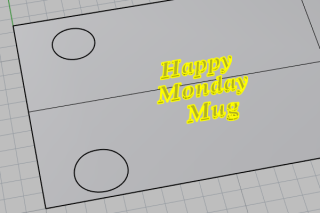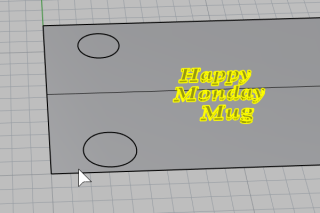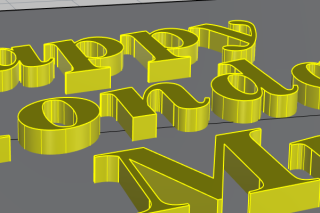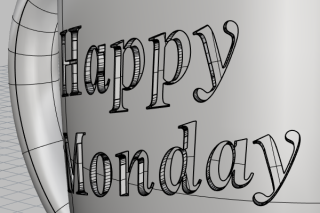
This tutorial demonstrates wrapping solid text objects onto a mug. These text objects could be used to Boolean with the mug.

You will learn how to:
On the Rhino Help menu, click Learn Rhino, and then click Tutorials and Samples.
In the Tutorials panel, under User's Guide, double-click the tutorial model file Wrap.3dm.
The CreateUVCrv command generates the planar border and trimmed curves of a surface that can be used as a guide to orient your text objects.
Start the CreateUVCrv command.
(Curve > Curve from Objects > Create UV Curves)
Select the side surface of the mug, press Enter.
A rectangle and two circles are created on the Top construction plane starting from the origin. The rectangle represents the side surface boundary. The two circles are where the handle join to the side surface.

Select the rectangle.
Run the PlanarSrf command.
(Surface > Planar Curves)
An untrimmed planar rectangle surface is created.

Delete the rectangle curve.
Start the TextObject command.
(Solid > Text...)
Select a font and set Height to 1.0.
Type your text.
Under Output, select Solids and set Thickness to 0.2.
Check Group output.
Click OK and place the text on the planar surface inside the rectangle boundary.

Select the text object group.
On the status bar, click Record History.
Start the FlowAlongSrf command.
(Transform > Flow along Surface)
Set the command-line options Copy=Yes, Rigid=No, and AutoAdjust=Yes.
Select the planar surface near the lower-left corner and close to the lower edge.
This is the base surface.

Select the mug side surface at the corresponding position.
This is the target surface.
The text objects are wrapped onto the mug.


If the base or target surface is not selected at the correct corresponding position, the text objects will be wrapped with a wrong orientation. When it happens, undo the command and try again.
Use Gumball to Move, Rotate, and Scale the text objects on the planar surface inside the rectangle boundary.
Let History update the text objects on the mug.
Move the text objects down to intersect with the planar surface.


History updates the text objects to intersect with the mug.
Boolean operations will break History connection. Click OK when you see the History Warning.
Use the BooleanDifference command to subtract the text objects from the mug.
(Solid > Difference)

Or, use the BooleanUnion command to combine the text objects into the mug.
(Solid > Union)

Rhino for Windows © 2010-2018 Robert McNeel & Associates. 24-Nov-2021